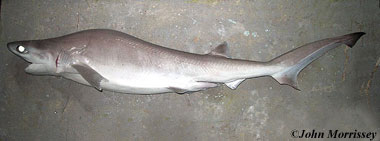
Hexanchus nakamurai
This slender deep-water shark has a small dorsal fin far along its back, large reflective green eyes, and six gill slits rather than the usual five that most sharks have. It is usually dark to light gray on top, fading to white underneath, and usually grows to from 5.5 to under 6 feet long. Little is known about this shark’s life but because of its size and deep-water habits, it isn’t considered a threat to humans.
Order – Hexanchiformes
Family – Hexanchidae
Genus – Hexanchus
Species – nakamurai
Common Names
The English language common name referring to this shark is bigeye sixgill shark in reference to its large eyes and six gill slits. Other common names include cañabota ojigrande (Spanish), canhabota olho grande (Portuguese), cazón de fondo (Spanish), griset (French), Grootoog-seskiefhaai (Afrikaans), grootoogzeskieuwshaai (Dutch), pating (Tagalog), and requin-vache (French).
Importance to Humans
Of only slight importance to fisheries, the bigeye sixgill shark is caught on line gear and in trawls.
Danger to Humans
This shark is not considered dangerous to humans primarily due to its small size and deep water habitat. According to the International Shark Attack File, there have not been any attacks attributed to this species.
Conservation
> Check the status of the bigeye sixgill shark at the IUCN website.
The IUCN is a global union of states, governmental agencies, and non-governmental organizations in a partnership that assesses the conservation status of species.
Geographical Distribution
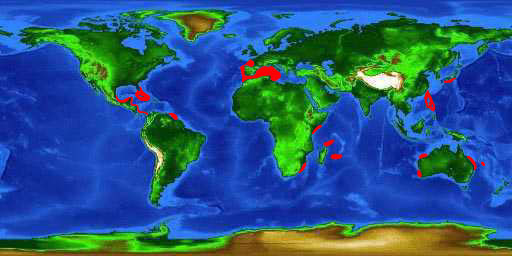
The bigeye sixgill shark is probably distributed worldwide in deep water. However it has been reported in the western Atlantic Ocean from Mexico to the Bahamas, northern Cuba, Nicaragua, and Costa Rica. In the eastern Atlantic, this shark is found from France south to Morocco, including the Mediterranean Sea. It may also reside off the coasts of Côte d’Ivoire and Nigeria. In the Indian Ocean, this shark lives off the eastern and southern coasts of the African continent and Aldabra Island (India). The distribution in the western Pacific Ocean includes Japan, Taiwan, Philippines, New Caledonia, and Australia.
Habitat
Although widely distributed, this shark has been reported in localized areas. Bigeye sixgill sharks are found on continental and insular shelves at depths from 295-1,970 feet (90-600 m). As a primarily deepwater species, the bigeye sixgill shark is usually found near the bottom substrate and may move toward the surface during the nighttime hours.
Distinguishing Characteristics
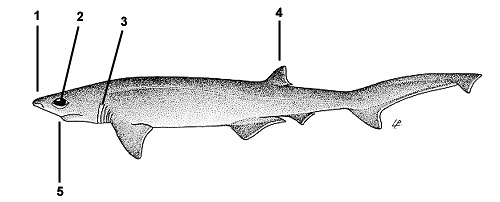
1. Head is narrow and pointed
2. Eyes are large
3. Six gill slits
4. Single dorsal fin
5. Upper jaw has 9 teeth on each side; the lower jaw has 5 comb-like teeth on each side of a small symphysial tooth
Biology
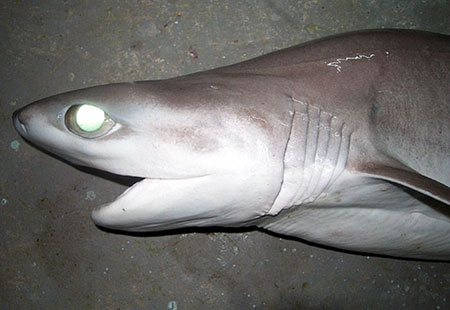
Distinctive Features
This shark is small and relatively slender with a somewhat flattened, narrow pointed head and large eyes. The mouth is ventrally located. There are six gill slits in contrast to the five gill slits that most sharks possess. The single dorsal fin is small with the origin ranging from over the posterior half of the base of pelvic fin to just behind the insertion point of the pelvic fin. The anal fin is smaller than the dorsal fin and the caudal peduncle is long and slender.
Other species appearing similar to the bigeye sixgill shark include the bluntnose sixgill shark (Hexanchus griseus) and the frill shark (Chlamydoselachus anguineus). The distinguishing feature of the much larger sixgill shark is the six large teeth of either side of the lower jaw in contrast to the bigeye sixgill shark which only has five teeth on each side of the lower jaw. The frill shark can be identified by a terminal rather than ventral mouth and fang-like teeth.
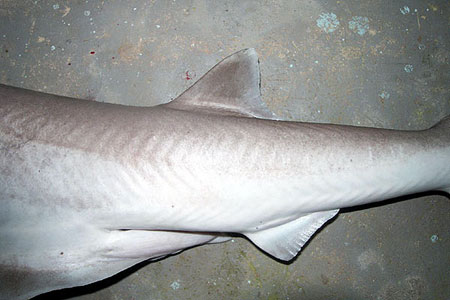
Coloration
The dorsal surface of the bigeye sixgill shark is dark to light brownish gray, paling to a lighter underside. The trailing edges of the fins have white margins. Live specimens have fluorescent green eyes. Juveniles have a black-tipped upper caudal fin.
Dentition
The ventrally located mouth contains nine teeth on each side of the upper jaw and 5 teeth on each side of the small symphysial tooth in the lower jaw. The first two teeth in the upper jaw each have a narrow hooked cusp and lack cusplets. The remaining teeth become wider and have more lateral cusplets toward the corners of the upper jaw. There is one small symphysial tooth centrally located on the lower jaw. Each side of the lower jaw has five large teeth that are wide and comb-like, each with a cusp and several large cusplets.
Size, Age, and Growth
The maximum size of the bigeye sixgill shark is 5.9 feet (1.8 m) total length. The average size of this species is 5.6 feet (1.7 m) with weights around 44 pounds (20 kg). Males mature at 4.0-5.2 feet (1.2-1.6 m) in length and females at 4.7-5.8 feet (142-178 cm).
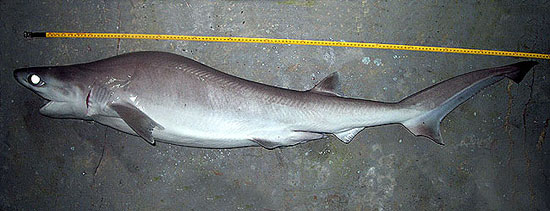
Food Habits
Little is known regarding the feeding habits of this shark. Shark biologists believe that it probably feeds on small to medium-sized bony fishes as well as a variety of bottom dwelling invertebrates. A small tuna was found in one specimen’s stomach contents, suggesting that the bigeye sixgill shark may feed at the surface.
Reproduction
The bigeye sixgill shark is ovoviviparous. Litter size may number up to 13, with each pup measuring approximately 17 inches (43 cm) at birth.
Predators
Large sharks are potential predators of the bigeye sixgill shark.
Taxonomy
The bigeye sixgill shark was originally described as Hexanchus griseus nakamurai (Teng 1962) due to its close relation to the bluntnose sixgill shark Hexanchus griseus. However, this name was later changed to the currently valid name of Hexanchus nakamurai (Teng, 1962). The genus name Hexanchus is derived from the Greek “exa” meaning six and “agcho” meaning narrow. The species name nakamurai honors Teng’s colleague H. Nakamura. Hexanchus vitulus Springer & Waller 1969 is a synonym used in previous scientific literature that refers to this species.
An interesting side note: Stewart Springer and Richard Waller described this shark from specimens caught in the western North Atlantic Ocean, naming it Hexanchus vitulus. However, it appears they did not realize that seven years previously, H. T. Teng described the same species in his doctoral dissertation. It is disputed whether Teng’s description is a formal publication. In 1991, it was concluded that the name H. nakamurai is a valid name as copies of Teng’s dissertation was widely distributed to Japanese ichthyologists when it was originally written. This conclusion is now widely accepted, with revisions expected in upcoming publications.
Prepared by: Cathleen Bester